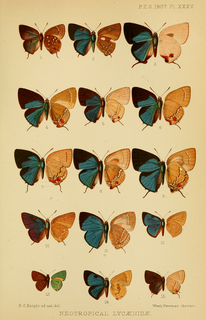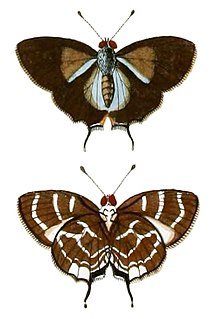Related Research Articles

William Chapman Hewitson was a British naturalist. A wealthy collector, Hewitson was particularly devoted to Coleoptera (beetles) and Lepidoptera and, also, to birds' nests and eggs. His collection of butterflies, collected by him as well as purchased from travellers throughout the world, was one of the largest and most important of his time. He contributed to and published many works on entomology and ornithology and was an accomplished scientific illustrator.

Arawacus is a genus of butterflies in the family Lycaenidae. They are commonly called stripestreaks. The species of this genus are found in the Neotropic ecozone.

Strephonota is a Neotropical genus of butterflies in the family Lycaenidae. The genus was erected by Kurt Johnson, George T. Austin, Jean Francois Le Crome and Julián A. Salazar E. in 1997.

Thereus is a genus of gossamer-winged butterflies. Among these, it belongs belong to the tribe Eumaeini of the subfamily Theclinae. These small butterflies occur essentially all over the Neotropics.

Tmolus is a Neotropical genus of butterflies in the family Lycaenidae. The genus was erected by Jacob Hübner in 1819.
Dalla is a genus of skippers in the family Hesperiidae.

Adelpha is a genus of brush-footed butterflies found from the southern United States and Mexico to South America. They are commonly known as sisters, due to the white markings on their wings, which resemble a nun's habit. This genus is sometimes included with the admiral butterflies (Limenitis).

Mimoides is a genus of butterflies in the family Papilionidae. The species native to the Americas were formerly in genus Eurytides.
Dismorphia zathoe, the zathoe mimic white is a butterfly in the family Pieridae. The species was first described by William Chapman Hewitson in 1858. It is found in Central America and northern South America.
Strymon crambusa is a butterfly of the family Lycaenidae. It was described by William Chapman Hewitson in 1874. It is found in Brazil and Bolivia.

Strymon istapa the mallow hairstreak, mallow-scrub hairstreak, dotted hairstreak or Hewitson's hairstreak. This diurnal butterfly is a widespread species that can be found in xeric habitats throughout the southern United States, Central America, parts of the Caribbean, and rarely in South America. This species can be spotted in rural and suburban areas in which human infringement has created open fields or tracks of overgrown weeds as a result of land clearing. These butterflies are often seen rubbing their hindwings together presumably to attract attention to their antenna mimicry scales located on the outer margin of the hindwing.
Strymon mulucha is a butterfly of the family Lycaenidae. It was described by William Chapman Hewitson in 1867. It is found in Guatemala, Costa Rica, the Amazon region of Brazil, Venezuela and Colombia.
References
- ↑ Savela, Markku (January 15, 2017). "Strymon daraba (Hewitson, 1867)". Lepidoptera and Some Other Life Forms. Retrieved February 4, 2020.
- "Strymon daraba (Hewitson, 1867)". Insecta.pro. Retrieved February 4, 2020.
| This Eumaeini-related article is a stub. You can help Wikipedia by expanding it. |